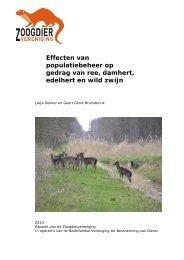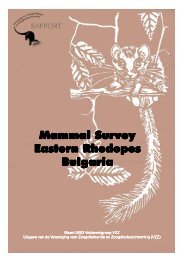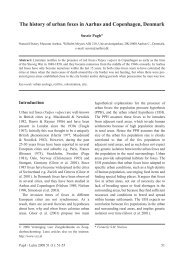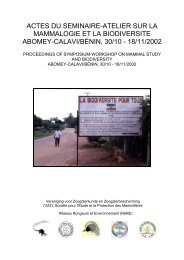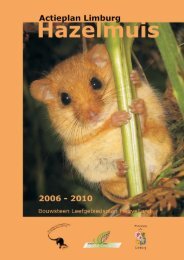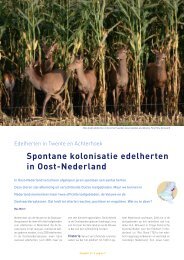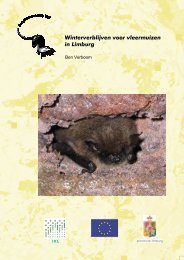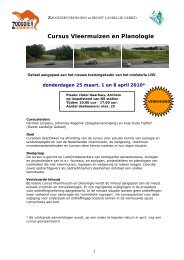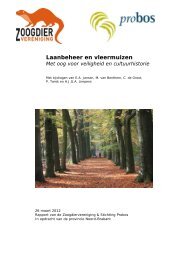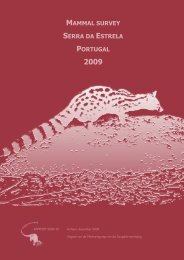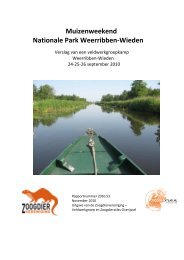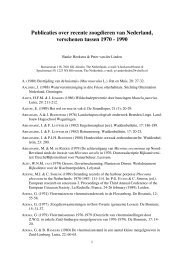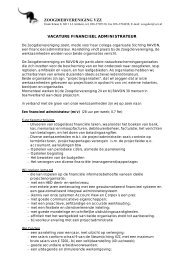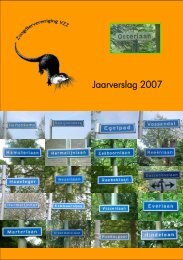Mammal survey Pol'ana - De Zoogdiervereniging
Mammal survey Pol'ana - De Zoogdiervereniging
Mammal survey Pol'ana - De Zoogdiervereniging
Create successful ePaper yourself
Turn your PDF publications into a flip-book with our unique Google optimized e-Paper software.
Red Red fox fox ( (Vulpes ( Vulpes Vulpes vulpes vulpes) vulpes<br />
The red fox is quite abundant in the area. During the night, foxes were spotted easily with the use of strong<br />
searchlights on the acres bordering the woods of Pol’ana. Also coincidentally, foxes were encountered during<br />
most nightly activities – including one occasion where the fox was so stupefied that it dropped its prey from<br />
its mouth. All together, this resulted in close to 20 sightings. Furthermore, fox droppings were found.<br />
Brown Brown bear bear bear ( (Ursus ( Ursus arctos arctos) arctos<br />
Though not sighted, the presence of the brown bear was indisputable by the marks it left on trees and by its<br />
faeces. The scratching on the bark of a tree by the bear’s nails leaves distinct vertical lines, accompanied by<br />
fresh resin on the coniferous trees. Bear faeces are often clearly visible, laying on pathways. On one location<br />
bear droppings were seen, on three locations marks on the trees, and on one place situated north of Látky<br />
droppings, bark marks and tracks of adult and young brown bear occurred all together. The locations were<br />
spread throughout the research area. For more detailed information on bear tracks see section 4.4. The<br />
Carpathian bear population is Europe’s most numerous with 7500 individuals (Mitchell-Jones et al., 1999).<br />
Stoat Stoat ( (Mustela ( ( Mustela erminea erminea) erminea<br />
Two stoats are spotted in the research area. One of them was successfully hunting down a young souslik. A<br />
third recording concerns tracks of Mustela spec. The stoat is probably present in the whole country, as is the<br />
weasel (M. nivalis) and the western polecat (M. putorius, see below). The steppe polecat (M. eversmanii) is<br />
absent in Pol’ana and shows a more southern and eastern distribution in Slovakia (Mitchell-Jones et al.,<br />
1999).<br />
Western Western Western polecat polecat ( (Mustela ( Mustela putorius putorius) putorius<br />
As a western polecat was crossing the road right in front of one of our cars, its characteristics were clearly<br />
lighted up during the late evening. This was on the road alongside the reservoir north of Hriňová. Three days<br />
later, once more a western polecat was sighted under similar conditions but this time close to the camp<br />
location in Látky. The two locations are about 7 km apart. The population density of this species is generally<br />
low, 1/1000 ha to 5 or 10/1000 ha on the best locations (Mitchell-Jones et al., 1999). One western<br />
polecat per 1000 ha equals 1 per 10 km2 , so it might concern the same individual.<br />
Beech Beech Beech marten marten ( (Martes ( Martes foina foina) foina<br />
The beech marten is also present, next to its relative the pine marten. One individual was noticed crossing a<br />
bridge of a small road at night, as it followed a small stony stream bordered with trees on both sides. It was<br />
calling to another individual that stayed behind a little. On another location, two juveniles where seen on a<br />
gravel road in the woods. In total, the sightings concern four locations and seven beech martens. On top of<br />
that, Martes sp. latrines in the attics of churches, barns and the like were found. And some sightings revealed<br />
not enough details to positively determine the species of marten. Concluding, martens are quite prevalent<br />
around Pol’ana.<br />
Pine Pine marten marten ( (Martes ( Martes martes martes) martes<br />
On several spots in the area, droppings of probably pine marten were found. The smell can make it<br />
distinguishable from the beech marten’s faeces, though this is not a conclusive argument. On one occasion,<br />
the pine marten itself was seen. The species is common in this part of Europe.<br />
Badger Badger ( (Meles ( Meles meles meles) meles<br />
Only one badger was recorded during the research period by footprints in the mud (near the reservoir north<br />
of Hriňová). In the Czech Republic and in Slovakia the population density of 0.1-0.6 adults per km2 constitutes Europe’s lowest (Mitchell-Jones et al., 1999).<br />
Otter Otter ( (Lutra ( Lutra lutra lutra) lutra<br />
Otter tracks were present on several locations within the area (12 recordings in total). Spraints on stones and<br />
footprints on the river banks and lake shores stated its presence. See also section 4.4 for more track details.<br />
The otter occurs in the whole of Slovakia except for a part of the west.<br />
<strong>Mammal</strong> <strong>survey</strong> <strong>Pol'ana</strong> (Slovakia) 2005 25



